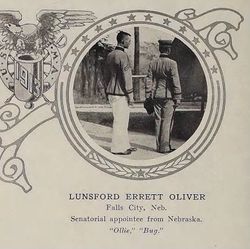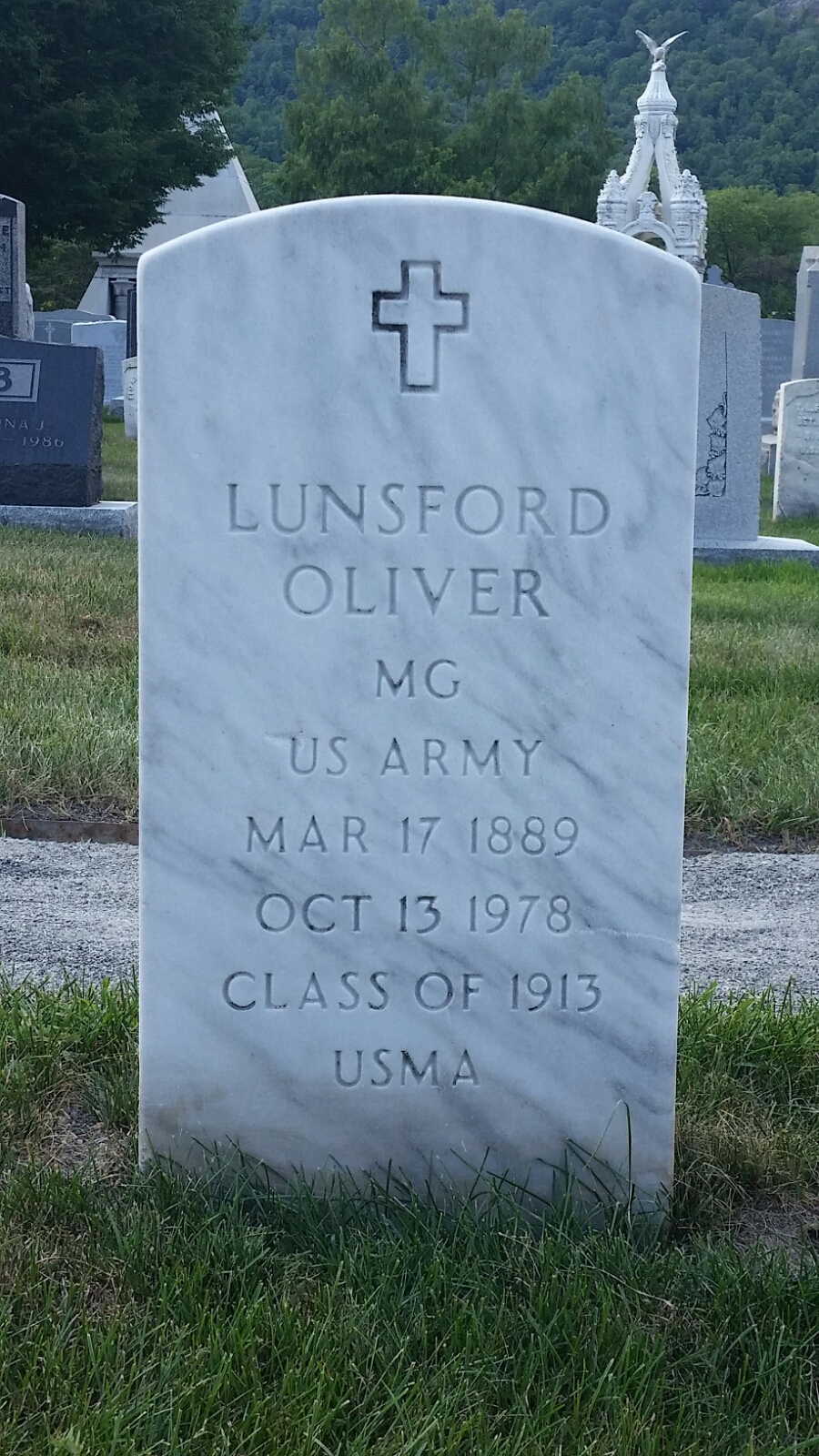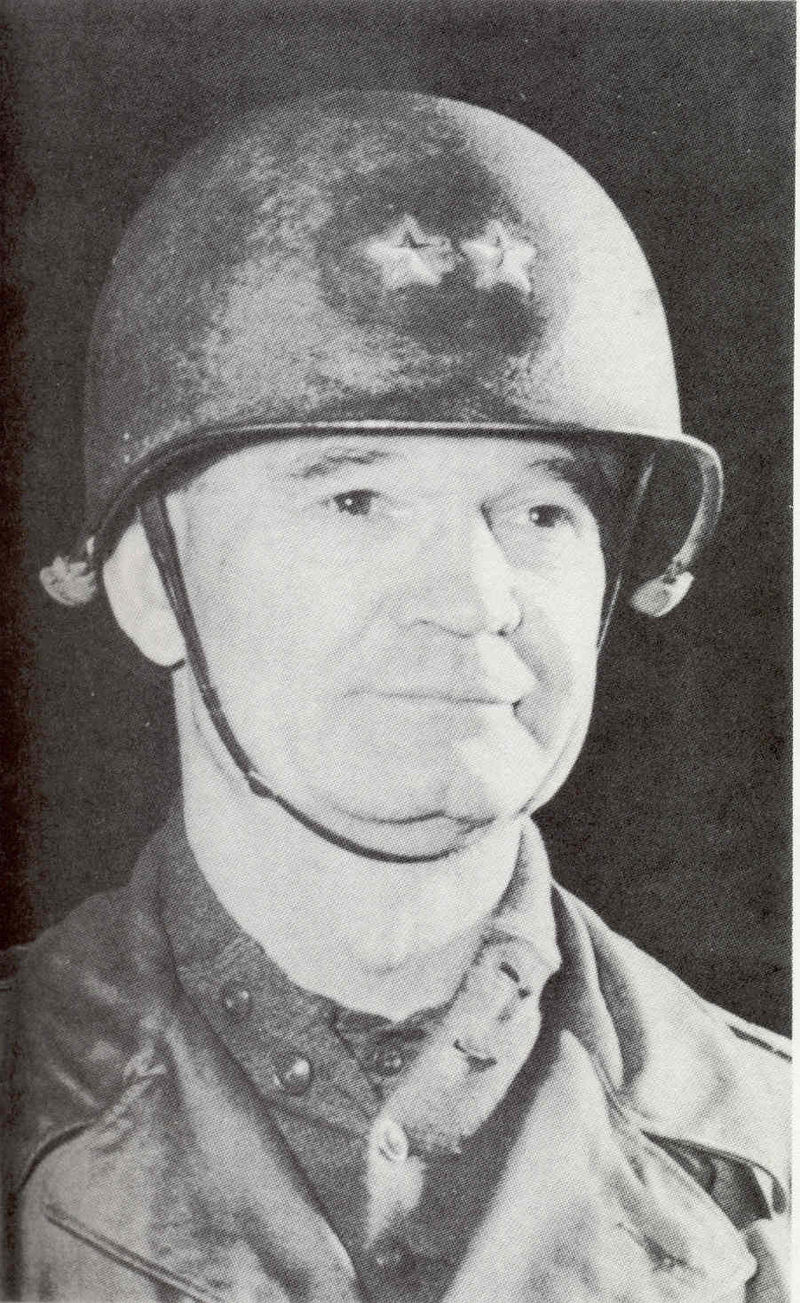Lunsford Errett Oliver was born on March 17, 1889 in Nemaha, Nebraska. After his graduation from West Point, he received his commission in the Corps of Engineers. During World War I he organized and trained a number of railway engineer battalions in the United States. In 1921 he married Janet Putnam, the younger sister of his West Point roommate, Rufus Putnam. Between World War I and World War II his assignments included being the Chief Engineer for the Francis Scott Key Bridge in the District of Columbia; Engineer on the Alaska Road Commission in Juneau, Alaska and District Engineer for the Vicksburg District on the Mississippi River, for flood control work. He attended the Command and General Staff School at Fort Leavenworth, Kansas, later returning as an instructor, and also attended the Army War College. He later returned to the Staff School as an instructor. At the beginning of World War II. he was armored Force Engineer at Fort Knox, where he was responsible for development and adoption of the modern steel bridge using rubberized fabric pontoons. In January 1941 he was promoted to brigadier general and assigned to the 1st Armored Division as commander of Combat Command B. He led this command during the landing at Oran in North Africa in November 1942 and then into Tunisia. Here he led the first American ground forces to fight against the Germans in World War II. He was promoted to major general and returned to the United States in December 1942. In March 1943, he took command of the 5th Armored Division, which he led for the remainder of World War II. In August 1944, following the breakthrough from the Normandy beachhead, the 5th Armored led the drive which created the Falaise-Argentan pocket. In September 1944, patrols of the 5th Armored were the first of Allied units to set foot on German soil and to breach the Siegfried Line. In April 1945, the division went out a hundred miles in front of supporting infantry and fought its way to the Elbe river, closer to Berlin than any other American unit. It was stopped there by order from the Ninth Army. His awards included two Distinguished Service Medals, a Silver Star, two Legion of Merits, three Bronze Stars and the Order of Orange Nassau, with Swords, degree of Grand Officer, from the Netherlands. In September 1945, he returned to the United States. The 5th Armored Division presented a plaque to him after World War II that was inscribed with the following:
Presented to Major General Lunsford E. Oliver by his comrades-in-arms, the former members of The 5th Armored Division in gratitude for his courage and leadership on the field of battle and in time of peace; to acknowledge his earnest and unstinting care for his officers and men; to mark our realization and admiration for his dignity, simplicity and unselfishness and our recognition of the fine example of true Americanism that he has set for all. No division had a more beloved leader.
He had several assignments, including being the head of a survey group sent to Turkey. In May 1948, he retired. He and his wife moved to an old farm house in Williamsburg, Massachusetts. He headed a fund drive which led to the construction of a chapel on the grounds of the Veterans Hospital at Northampton, Massachusetts and acted as Clerk of the Works for Smith College for the construction of new dormitories. Survivors included his wife, a son, USMA Class of June 1943 and two daughters.
Source: United States Military Academy Association of Graduates memorial.
Lunsford Errett Oliver was born on March 17, 1889 in Nemaha, Nebraska. After his graduation from West Point, he received his commission in the Corps of Engineers. During World War I he organized and trained a number of railway engineer battalions in the United States. In 1921 he married Janet Putnam, the younger sister of his West Point roommate, Rufus Putnam. Between World War I and World War II his assignments included being the Chief Engineer for the Francis Scott Key Bridge in the District of Columbia; Engineer on the Alaska Road Commission in Juneau, Alaska and District Engineer for the Vicksburg District on the Mississippi River, for flood control work. He attended the Command and General Staff School at Fort Leavenworth, Kansas, later returning as an instructor, and also attended the Army War College. He later returned to the Staff School as an instructor. At the beginning of World War II. he was armored Force Engineer at Fort Knox, where he was responsible for development and adoption of the modern steel bridge using rubberized fabric pontoons. In January 1941 he was promoted to brigadier general and assigned to the 1st Armored Division as commander of Combat Command B. He led this command during the landing at Oran in North Africa in November 1942 and then into Tunisia. Here he led the first American ground forces to fight against the Germans in World War II. He was promoted to major general and returned to the United States in December 1942. In March 1943, he took command of the 5th Armored Division, which he led for the remainder of World War II. In August 1944, following the breakthrough from the Normandy beachhead, the 5th Armored led the drive which created the Falaise-Argentan pocket. In September 1944, patrols of the 5th Armored were the first of Allied units to set foot on German soil and to breach the Siegfried Line. In April 1945, the division went out a hundred miles in front of supporting infantry and fought its way to the Elbe river, closer to Berlin than any other American unit. It was stopped there by order from the Ninth Army. His awards included two Distinguished Service Medals, a Silver Star, two Legion of Merits, three Bronze Stars and the Order of Orange Nassau, with Swords, degree of Grand Officer, from the Netherlands. In September 1945, he returned to the United States. The 5th Armored Division presented a plaque to him after World War II that was inscribed with the following:
Presented to Major General Lunsford E. Oliver by his comrades-in-arms, the former members of The 5th Armored Division in gratitude for his courage and leadership on the field of battle and in time of peace; to acknowledge his earnest and unstinting care for his officers and men; to mark our realization and admiration for his dignity, simplicity and unselfishness and our recognition of the fine example of true Americanism that he has set for all. No division had a more beloved leader.
He had several assignments, including being the head of a survey group sent to Turkey. In May 1948, he retired. He and his wife moved to an old farm house in Williamsburg, Massachusetts. He headed a fund drive which led to the construction of a chapel on the grounds of the Veterans Hospital at Northampton, Massachusetts and acted as Clerk of the Works for Smith College for the construction of new dormitories. Survivors included his wife, a son, USMA Class of June 1943 and two daughters.
Source: United States Military Academy Association of Graduates memorial.
Family Members
Sponsored by Ancestry
Advertisement
Advertisement














